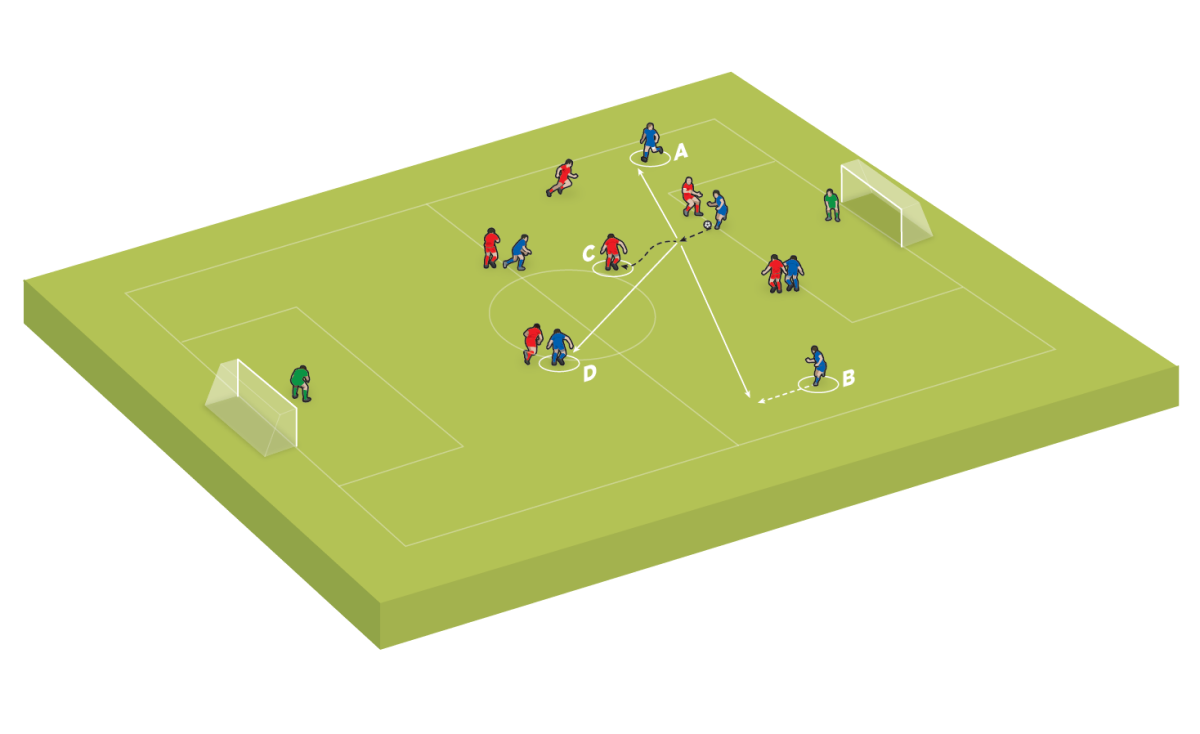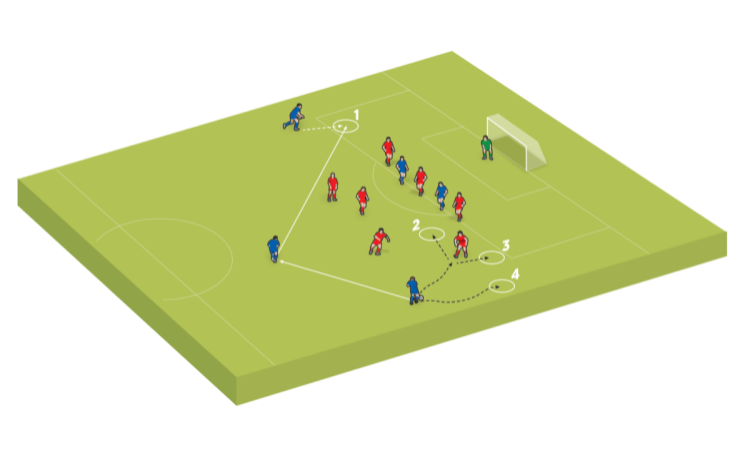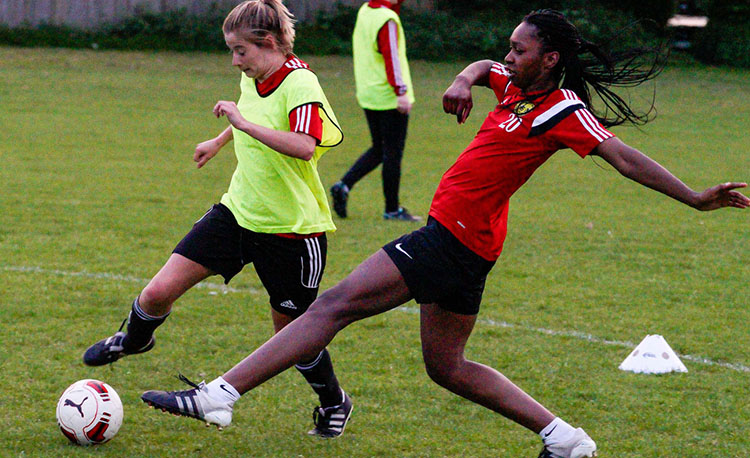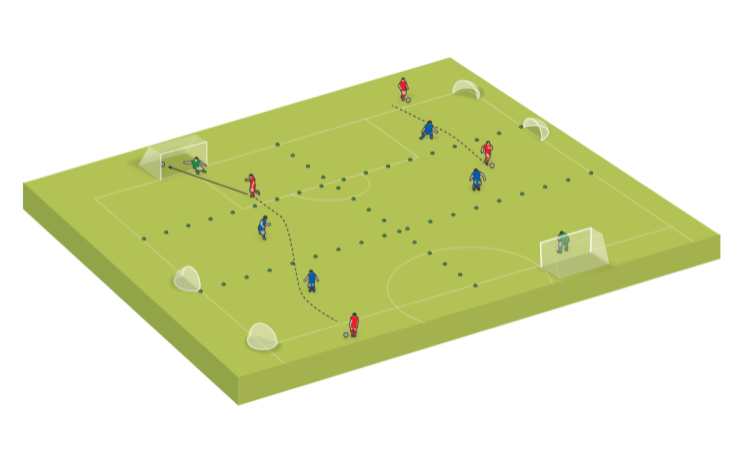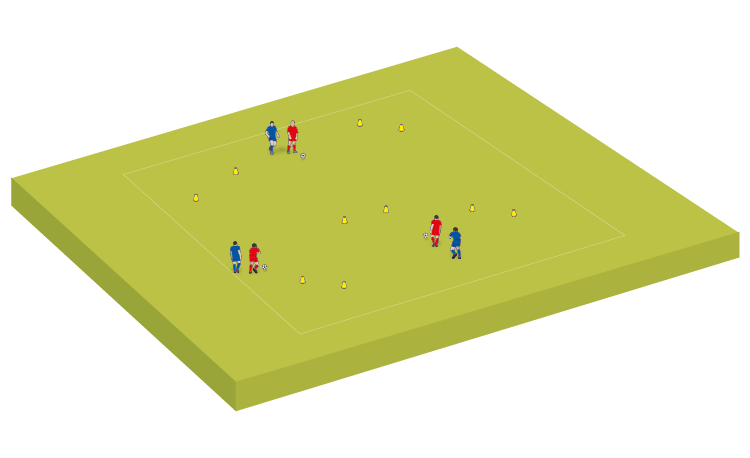Tactical dilemmas: Winning the ball on the edge of the penalty area
A centre-back wins the ball on the edge of their own penalty area. What is their most effective next move? Ian Barker gives the pros and cons of four options
The initial motivation for creating multiple-choice tactical scenarios such as this one was a bit of fun.
Over time, however, the discussions they have generated among players and coaches has offered some interesting insight into how the game is perceived in different ways.
No right or wrong is strictly suggested in scenarios such as this. Rather, coaches and players are encouraged to choose which option they prefer based on the image provided, and any additional scene setting.
In a 7v7 training game, the central defender dispossesses an opposing forward on top of the box and controls the ball in a deep central position. The options for the player are:
A. Play the ball to their right sided support player.
B. Play the ball to their left sided support player.
C. Dribble forward and commit an opponent.
D. Player a longer pass to the most advanced teammate.
Weighing up the options
In this example, option A seems low risk, but not very positive. It also fails to play away from where opponents are. However, in a model of play designed to draw opponents into small spaces and then break from them, this might be a very important option.
Option B allows for the ball to be played to space with a relatively low-risk pass, allowing the player to take the ball on in stride. It looks like a good option. However, the player receiving the ball is very deep and a considerable distance from the opponent’s goal.
Option C commits an opponent on the dribble and potentially unbalances the overall team shape. It is very positive but would be high risk. If the player who has won the ball were to turn it over, the opponent has a very short and direct route to goal.
Option D requires technical execution of a long pass and the ability of the forward to pin the defender and shield the ball. It might be considered too direct, or it may be considered the most positive option in breaking opposition lines and getting the ball into advanced areas.
When I originally created this scenario, my preference was for Option D. My thought was that if the ball can be held by the forward, the left-sided player can move up to support and create an overload situation.
"Throwing into space rather than directly to a team-mate is good as it turns defences..."
The forward can use the run of the left-flank player to drop the ball and turn in combination, or use the run to draw opponents so turning with the ball may be possible.
Option B was appealing. However, if “the ball can do the work” then I would rather the left-sided player run forward from deep rather than have to carry the ball.
Option A seemed fair, but not positive. However, the more I watch possession-based playing styles, represented most clearly in the Premier League by Manchester City and Arsenal, I appreciate it could be used to draw opponents into small spaces and then from there to spring counter attacks.
Option C was originally offered by me as the weakest option by far. With both my coaching and playing hats on, my risk-averse nature would never support dribbling out from the back so directly when passing options prevailed.
However, when I showed the scenario to a group of very competent 13-year-olds, several chose Option C over the other three.
The rationale offered was that this was a training game and that in their club environments they are encouraged to take opponents on whenever an opportunity arises.
As 13-year-olds, their club supports technical execution and a positive mentality over tactical soundness. As such, the club has a developmental philosophy no more or less valid than my risk-averse interpretation of the scenario.
Please share this scenario with your peers and players. Use it to foster discussion and debate and enjoy the inevitable richness of the different perspectives and ideas.
How you voted
What should the centre-back do now?
— Soccer Coach Weekly (@SoccerCoachWeek)
A. Play the ball to their right sided support player
B. Play the ball to their left sided support player
C. Dribble forward and commit an opponent
D. Player a longer pass to the most advanced teammateWhat should the centre-back do now?
— Soccer Coach Weekly (@SoccerCoachWeek) April 13, 2023
A. Play the ball to their right sided support player
B. Play the ball to their left sided support player
C. Dribble forward and commit an opponent
D. Player a longer pass to the most advanced teammate
Related Files
Subscribe Today
Subscriber Testimonials

Rick Shields, Springboro, USA

Tony Green, Pierrefonds Titans, Quebec, Canada

Gerald Kearney, Downtown Las Vegas Soccer Club

Paul Butler, Florida, USA

Rick Shields, Springboro, USA

Tony Green, Pierrefonds Titans, Quebec, Canada

Gerald Kearney, Downtown Las Vegas Soccer Club

Paul Butler, Florida, USA
Subscribe Today
Newsletter Sign Up
Coaches Testimonials

Rick Shields, Springboro, USA

Tony Green, Pierrefonds Titans, Quebec, Canada

Gerald Kearney, Downtown Las Vegas Soccer Club

Paul Butler, Florida, USA

Rick Shields, Springboro, USA

Tony Green, Pierrefonds Titans, Quebec, Canada

Gerald Kearney, Downtown Las Vegas Soccer Club

Paul Butler, Florida, USA
Subscribe Today
Discover the simple way to become a more effective, more successful soccer coach
In a recent survey 89% of subscribers said Soccer Coach Weekly makes them more confident, 91% said Soccer Coach Weekly makes them a more effective coach and 93% said Soccer Coach Weekly makes them more inspired.
*includes 3 coaching manuals
Get Weekly Inspiration
All the latest techniques and approaches
Soccer Coach Weekly offers proven and easy to use soccer drills, coaching sessions, practice plans, small-sided games, warm-ups, training tips and advice.
We've been at the cutting edge of soccer coaching since we launched in 2007, creating resources for the grassroots youth coach, following best practice from around the world and insights from the professional game.
